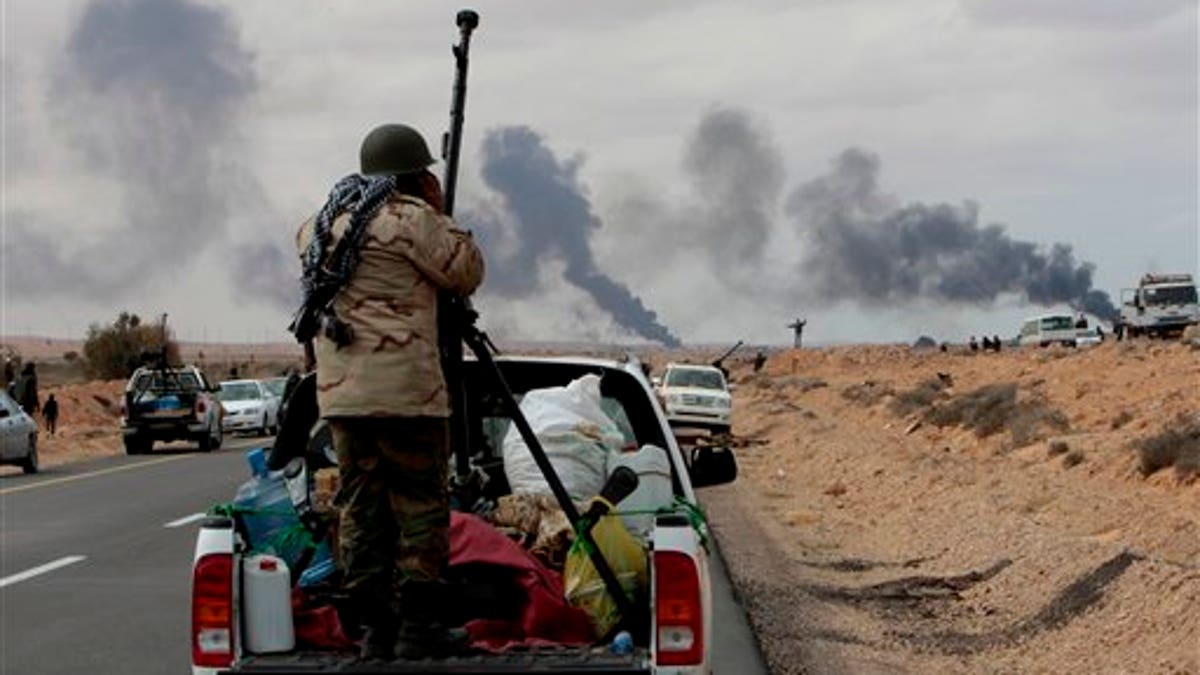
Anti-Libyan Leader Moammar Gadhafi rebel, stands behind his anti-aircraft machine gun as smokes rises from shell impacts in the distance during fighting against pro-Moammar Gadhafi forces, in Sedra, eastern Libya, on Wednesday March 9, 2011. Gadhafi appeared to be keeping up the momentum he has seized in recent days in his fight against rebels trying to move on the capital, Tripoli, from territory they hold in eastern Libya. (AP Photo/Hussein Malla)
In war coverage, the difference between anecdote and tragedy is razor thin. Viewed from home, it all looks like a Bruce Willis film; the bullets and missiles cutting through the air near a reporter’s head in battle are enormously entertaining as long as they don’t hit. Even on the killing ground, there is an almost festive aspect to a near miss. “That was close,” is often uttered with a nervous smile; grim humor substituting for crippling fear. Especially back away from the front, a kind of denial prevails; a jocular back slapping that is often slap happy, hail fellows well met, so near yet so far, fortune favors the brave, no guts no glory.
Then someone gets killed and anecdote and cliché collapse into mourning.
The sudden deaths in the besieged, beleaguered city of Misrata, Libya of photojournalists Tim Hetherington and Chris Hondros came as the two veteran reporters pushed themselves as close to the house-to-house fighting as physically possible. Both men were death’s intimate familiars. Hetherington worked with Sebastian Junger on the Academy-award nominated film, “Restrepo,” which for a year followed one platoon of the 503rd infantry Regiment, 173rd Airborne Brigade in the deadliest valley in Afghanistan.
Hondros’ Libyan pictures published the day he died showed that he was shoulder-to-shoulder with the anti-Gaddafi fighters; enduring the same risks they did as they held their tenuous urban line against ferocious, indiscriminate, unrelenting attack by Libyan government forces.
The pair apparently suffered fatal injury when an RPG, a rocket-propelled grenade hit near their position. Two other newsmen Michael Brown and Guy Martin were treated for shrapnel injuries and are lucky to be alive.
Reporters aren’t bullet-proof and we are granted no special protection in battle. Beginning with Afghanistan foreign reporters became fair game. The old days when we could pass for neutral observers are long gone. The violence associated with the “Arab Spring” uprisings has claimed at least four reporters lives, many others have been injured, kidnapped, and abused, male and female.
The irregular nature of the fighting adds peril. There is no disciplined unit with which to “embed.” No reliable line to advance behind or safe haven to retreat.
On the Eastern front in Libya, there is only the rag-tag rebel army that roars with bravado until confronted. They fire their weapons wildly, and shout Allah Akbar as if Allah cared about their macho posturing. Then, at the first sign of a determined counter-attack, they run. Their whining incompetence makes them unfit to wear the title ‘freedom fighter’; even ‘rebel’ sounds too grandiose for these poseurs. These gangsters should not be armed by NATO; they should have their asses kicked into shape by French, Italian and British non-commissioned officers who can teach them not to run away when fired on; but to dig in, form a defensive line, send forces out to the flanks, and scouts up forward, and to shoot horizontally not vertically.
But it’s different in the western city of Misrata. There, the legend of the anti-Gaddafi-rebellion is being written. This will be the rebels’ Valley Forge; their Alamo and Stalingrad. There, courage and resolve are as plainly seen as the overwhelming force arrayed against them. There, as civilians are murdered by indiscriminate shelling and sniping, Libyan freedom fighters and the reporters chronicling their desperate bid for freedom, risk everything to hang on as the outside world debates whether to intervene.
The city of Misrata is being kept alive by its port, which allows meager re-supply of food, fighters and equipment. Access to the port should be guaranteed by NATO. International personnel should be sent ashore and warships brought closer in. An ultimatum should be sent to Gaddafi that any attack on the port will be considered a hostile act against NATO forces and responded to accordingly. The world can not allow Misrata to fall to Gaddafi, not after so many fighters and civilian men, women and children have died; not after those reporters mixed their blood with the fallen revolutionaries.
The people of Misrata are risking everything to rid their nation of the unelected tyrant who has ruled over them despotically for 42-years. The slain reporters had a different motivation. “Tim was in Libya to continue his ongoing multimedia project to highlight humanitarian issues during time of war and conflict,” Hetherington’s family said. And I’m sure that statement is true as far as it goes. But there is something else going on when a reporter defies the human instinct to run from danger, instead risking everything to get as close to that instant when experience wrestles with fate, luck and circumstance to decide whether obituary or anecdote prevails.
“We were saddened to learn of the death of film director and photographer Tim Hetherington while working in Misrata…Journalists across the globe risk their lives each day to keep us informed, demand accountability from world leaders and give a voice to those who would not otherwise be heard,” said White House press secretary Jay Carney. “The United States will work to do everything possible to assist those who were injured in getting the care they need. Our thoughts are with these brave journalists and their loved ones.”
My condolences too to his family, which said, “it is with great sadness we learned that our son and brother, photographer and filmmaker Tim Hetherington, was killed today…he will be forever missed.” And he will live forever.
Geraldo Rivera is Senior Columnist for Fox News Latino.
Follow us on twitter.com/foxnewslatino
Like us at facebook.com/foxnewslatino
